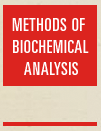BIOMEDICAL APPLICATIONS OF MASS SPECTROMETRY
METHODS OF BIOCHEMICAL ANALYSIS Volume 34

SERIES PREFACE
Methods of Biochemical Analysis was established in 1954 with the publication of Volume 1 and has continued to the present with volumes appearing on a more
or less yearly basis. Each volume deals with biochemical methods and techniques used in different areas of science. Professor David Glick, the series' originator and editor for the first 33 volumes, sensed the need for a book series that focused on
methods and instrumentation. Already in 1954, he noted that it was becoming increasingly difKcult to keep abreast of the development of new techniques and the improvement ofwell-established methods. This difficulty often constituted the limiting factor for the growth of experimental sciences. Professor Click's foresight marked the creation of a unique set of methods volumes which have set the standard for many other reviews.
With Profir Glick's retirement from the series and beginning with Volume 34, I have assumed editorship. Because the rationale used in 1954 for the
establishment of the series is even more cogent today, I hope to maintain the excellent traditions developed earlier. The format of Volume 34 and later volumes, however, is changed. Rather than cover a variety of topics as previous
volumes did, each volume will now focus on a specific method or the application
of a variety of methods to solve a specific biological or biomedical problem.
CLARENCE H. SUELTER
Eat Lansing, Michigan
Discusses how mass spectrometry may be applied to a variety of biological problems in a way that is meaningful to readers with varying degrees of knowledge about the subject. Rather than merely describing methods, it provides insights into approaches that mass spectroscopists have used to solve these problems. Each chapter offers guidance in appropriate ways to isolate and purify the compound class prior to analysis or characterization by mass spectrometry. Chapters also feature tutorials on mass spectral interpretations based on the fragmentation pathways commonly encountered for the particular compound type. Accounts are given of modern approaches to analysis based on fast-atom bombardment as well as more conventional analysis by electron impact and chemical-ionization mass spectrometry.
Download
*
METHODS OF BIOCHEMICAL ANALYSIS Volume 34

SERIES PREFACE
Methods of Biochemical Analysis was established in 1954 with the publication of Volume 1 and has continued to the present with volumes appearing on a more
or less yearly basis. Each volume deals with biochemical methods and techniques used in different areas of science. Professor David Glick, the series' originator and editor for the first 33 volumes, sensed the need for a book series that focused on
methods and instrumentation. Already in 1954, he noted that it was becoming increasingly difKcult to keep abreast of the development of new techniques and the improvement ofwell-established methods. This difficulty often constituted the limiting factor for the growth of experimental sciences. Professor Click's foresight marked the creation of a unique set of methods volumes which have set the standard for many other reviews.
With Profir Glick's retirement from the series and beginning with Volume 34, I have assumed editorship. Because the rationale used in 1954 for the
establishment of the series is even more cogent today, I hope to maintain the excellent traditions developed earlier. The format of Volume 34 and later volumes, however, is changed. Rather than cover a variety of topics as previous
volumes did, each volume will now focus on a specific method or the application
of a variety of methods to solve a specific biological or biomedical problem.
CLARENCE H. SUELTER
Eat Lansing, Michigan
Discusses how mass spectrometry may be applied to a variety of biological problems in a way that is meaningful to readers with varying degrees of knowledge about the subject. Rather than merely describing methods, it provides insights into approaches that mass spectroscopists have used to solve these problems. Each chapter offers guidance in appropriate ways to isolate and purify the compound class prior to analysis or characterization by mass spectrometry. Chapters also feature tutorials on mass spectral interpretations based on the fragmentation pathways commonly encountered for the particular compound type. Accounts are given of modern approaches to analysis based on fast-atom bombardment as well as more conventional analysis by electron impact and chemical-ionization mass spectrometry.
Download
*